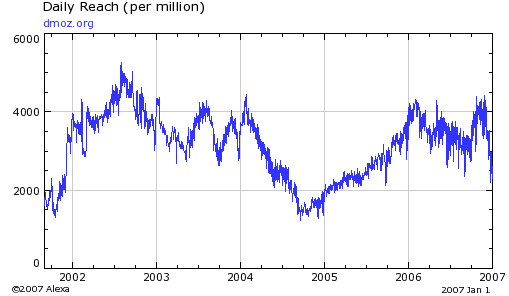 In Week 2 of our series of interviews with people in the Joomla world, we’re delighted to welcome Barrie North from JoomlaShack.com and CompassDesigns.net.
In Week 2 of our series of interviews with people in the Joomla world, we’re delighted to welcome Barrie North from JoomlaShack.com and CompassDesigns.net.
Barrie was kind enough to take a while out of his busy schedule to talk about template design, SEO and where he and Joomla are headed in 2007.
1) Hi Barrie. Could you tell us a little about yourself? How did you come to Joomla? What’s your background?
My background is pretty mixed. I started out as a rocket scientist. No – really! I have a Masters in Physics and spent a while at England’s Atomic Energy facility researching nuclear waste leakage. After starting to glow in the dark a bit (joke) I took a sideways step and taught High School math and science for a good five years in the US. I ended up helping start two schools, one for students that didn’t fit in the traditional mold that was very hands on in the classrooms. Most recently I decided to strike out myself into the business world. I think that I probably relate to some of the students that the school was for, someone who doesn’t fit into a traditional path! Who knows what I will do next…
2) Have you worked or designed with other systems apart from Joomla? If so, how do they compare?
I actually have not. I started a plain old vanilla web design business in 2005 and stumbled across Joomla. I quickly came to the conclusion that there was no real point in static web design. I would give my clients a CMS even if they hadn’t asked for one.
3) What are the origins of Joomlashack and what’s your role there? What can we expect to see from the site in 2007?
I joined Casey Lee as a partner at Joomlashack at the end of 2005. I rate Casey as one of the top designers around right now and I am honored to be working with him. We have grown as a team and have been joined by Waseem Sadiq and Dean Marshall in the UK and Cory Webb and Tom Elliott from the US. In 2007 we aim to push the envelope with Joomla template design. I am pretty sure that we were the first guys to come up with width/fontswitchers etc. which was has been a catalyst for other template shops to really innovate.
We are excited about 1.5 and hope to provide as much help and guidance for people with tutorials and examples that we pass on to the Joomla project. We just released a big one for 1.5 templating that Johan has up on the dev site now. I think the potential is very big for Joomla and more prominent sites/companies will be considering Joomla as a serious option. I think that the Shack is unique in the Joomlasphere in that we have a very strong commercial template identity and a strong custom development program. The University of Delaware, Yale Law Journal, Rochen and Tito Ortiz (!) will be sporting designs from the Shack this year.
4) In addition to running on of the largest Joomla companies around, you also have CompassDesigns.net. One of the remarkable things about this site is its SEO success. It ranks high in Google for almost every major Joomla-related keyword. Could you tell us a little about how you became so interested in SEO?
I think its my hard science background. I find SEO a really fascinating concept. Its an entire interdependent system governed by rules that we don’t really know. Its really like science, you can come up with theories, but all you can really do is set up experiments and test them, you can never know for sure. I have been pretty happy with the performance of www.compassdesigns.net, especially as its often the only site you will see in the top ten that doesn’t have the word Joomla in the URL! I should really put some ads on it or something 😉
5) What SEO resources would you recommend for someone working on improving the rankings of their Joomla site?
SEO resources, mmmmm. Well, there is the flawlessly written guide by those guys at Compass at http://www.compassdesigns.net (lol)
OK, seriously. I think I use all of these tools on a semi-daily basis:
http://www.pixelfast.com/overture/
http://www.webuildpages.com/cool-seo-tool/
http://www.webuildpages.com/neat-o/
http://www.webuildpages.com/seo-tools/top-competitor-tool.php
http://www.pr-prowler.com
http://www.wordtrackerkeywords.com (must have)
http://www.yourseobook.com
More recently I have been getting into Google Adwords:
http://www.perry-marshall.info
I used to use keyword density tools, but that strategy is becoming more diluted now.
6) What SEO strategies would you recommend for someone working on improving the rankings of their Joomla site?
OK, so here is the thing with “SEO”… its dead. What I mean here is that SEO used to be about stuffing some keywords onto your site and buying links and trying to game Google. It won’t work anymore. The point of Google is simple, it wants to match search terms with relevant content, and trust me, those Google guys and girls are smart, much smarter than we are. So trying to trick your way around the algorithm is fruitless. So a much better strategy is to embrace Google. Build high quality relevant content and THEN you will see traffic coming to it, for all the right reasons. This is where Joomla has the edge, its a CONTENT management system. Its DESIGNED to add lots of content quickly and efficiently, so use it. This is my advice again and again when I see people in the Joomla forums spending hours trying to get SEFXXXXX to work. Just ditch it and spend the time writing content instead. I honestly think that has been the success of compassdesigns.net, lots of (I try!) high quality content.
7) As someone highly involved in design and SEO, what benefits are you looking forward to with Joomla 1.5?
Hands down has to be the work Louis and Johan have done re-engineering the template system. There is now the potential to completely override the core content output in your template. If you are a University you can create an accessible and tableless site. It you are an SEO nut job like me, you can create a template that is a lean SEO machine. Looking into my crystal ball, I think you will see 3rd party providers creating these “template override packs” for various applications.
8) Do you have any new projects in 2007 we should be looking out for?
Well, I would have to do the obligatory shameless plug about my book. If I didn’t my publisher (Addisen) will send me mean emails! Its almost finished and due for publication Q2 of 2007. Its going to be an end users guide to help you go through building your site from scratch. I (hope) I have leaned heavily on my teacher background to write something thats highly readable and really teaches you some of the key concepts. Don’t worry, there are no homework assignments! Oh yeah, its also completely about 1.5, the new release of Joomla.
I plan to build the Compass blog more, really start digging into both Joomla and the world of a web business. Of course at Joomlashack we plan to continue to push the template envelope to show people what can be done with Joomla.
We have a couple of other things brewing, a component called IntelliJoomla to integrate Joomla into Intellicontact for example. Watch this space 🙂
 JoomlaYellowPages.com
JoomlaYellowPages.com We’re delighted to announce a new feature here at Alledia.
We’re delighted to announce a new feature here at Alledia.